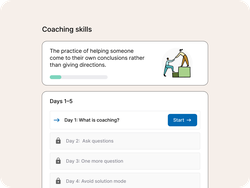
What L&D programs are missing: The magic of spaced repetition

Written by

Director of People Science Research, Culture Amp
Picture this: You’ve spent weeks finding the perfect vendor for your manager training, or better yet crafting your own program. Your managers log in and spend two hours learning the basics of giving good feedback, and practicing with one another, and at the end, they all say it was a valuable use of their time and they learned a lot. But in the following weeks, you hear comments from employees that things aren’t any better. Why does this happen? Why are humans so good at forgetting? And conversely, bad at remembering?
German psychologist Herman Ebbinghaus wondered the same thing. Asking the questions, “how quickly do we forget things?” and “how can we prevent it?” He took matters into his own hands. Ebbinghaus performed experiments on himself, memorizing unintelligible syllables and then seeing how quickly he forgot them. He found that within a day, 70% of what he learned had already been lost. And even though his experiments happened over a century ago, his findings have been found true over the decades.
But there’s good news. He also found the antidote – the spacing effect or spaced repetition. Spaced repetition is the act of distributing learning over time. For example, instead of spending two hours in a workshop on one day, having half-hour workshops across four days. Through spacing, the forgetting curve – that is, how quickly someone forgets what they learned – is softened, and some magic happens. Learners not only retain more information, but they’re also able to apply that learning in new ways.
How to use spaced repetition
Retain learning
Retention, or, the opposite of forgetting, is of course both the benefit and the goal of spaced repetition. It’s not enough for employees to learn something during training, It’s important for employees to keep it top of mind for months, and maybe years to come. According to one study, using spaced repetition helped students improve their recall (accuracy on the test) by up to 150%. But it’s not just successful in the laboratory or classroom, the spacing effect has also been demonstrated in the workplace.
Be more efficient with your managers’ time
Asking your employees to spend more time training to get the lessons to stick can seem like the solution. But the best part of spaced repetition is that it doesn’t require more time. What matters is how you break it up. When first-graders were taught in three two-minutes sessions a day, instead of a single six-minute session, after two weeks they saw six times the improvement in their reading skills. So you’re getting more “bang for your buck” – in the same amount of time, your managers could be retaining even more information. And with zoom fatigue these days, I’m sure your employees will thank you.
Help your managers apply learnings in new ways
The space in between training is when the real learning happens. You’re able to commit the learning to memory, start to make connections to how it applies in your day-to-day work, and test out the application of the concepts. In short, the “space” is where things truly start to “click.”
Employees aren’t always going to find the exact scenario or problem you’re trying to solve in their training. But by applying their learning to new scenarios, they can generalize that learning and use it as a solution for a variety of situations. Studies are beginning to research beyond just simple learning like vocabulary words and visual acuity. Instead, they are focusing on the complex learning that is included in most L&D programs. One study looked at the complex learning of food chains and found that if the learning was spaced out, students were more easily able to generalize.
How to apply spaced repetition to your programs
If you’re working on a training right now and want to apply the magic of the spacing effect, here are three quick tips:
- Break it up: Break your training down into shorter sessions spread across multiple days. The optimal gap depends on the specific learning objectives, but typically one day in between is best.
- Use a refresher: If you can’t break up your training across multiple days, consider having a short refresher training at a later date.
- Set up nudges: Incorporate nudges into your program like a small Slack reminder a couple of days after the training with a key learning. Bonus points if it includes an experiential exercise for the manager to practice putting the learning to use.

Find out if micro-learning can transform your managers
Learn more about Skills Coach

